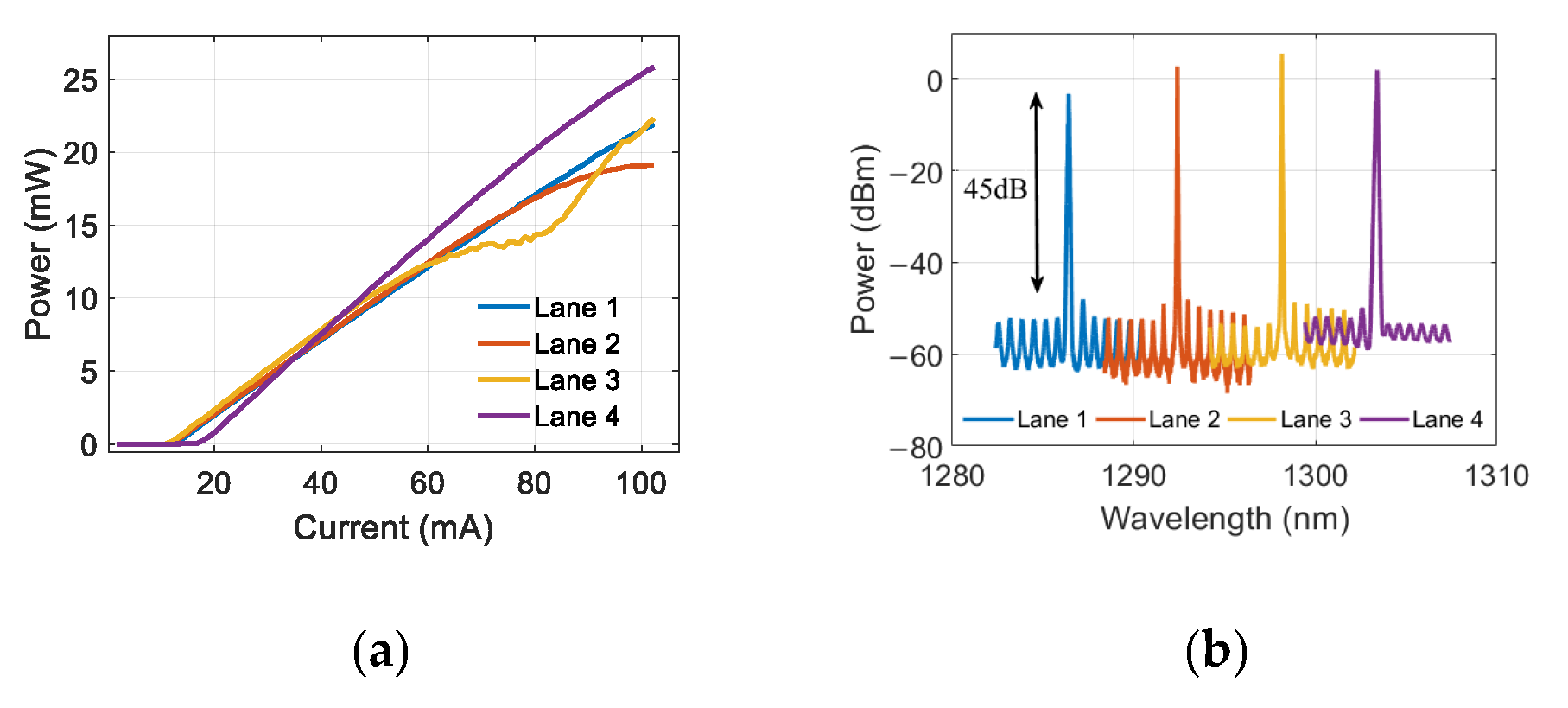A Directly Modulated Laterally Coupled Distributed Feedback Laser Array Based on SiO2 Planarization Process
Abstract
:1. Introduction
2. Device Structure, Design and Fabrication Methods
3. Results and Discussion
4. Conclusions
Author Contributions
Funding
Institutional Review Board Statement
Informed Consent Statement
Data Availability Statement
Conflicts of Interest
References
- Nakahara, K.; Wakayama, Y.; Kitatani, T.; Taniguchi, T.; Fukamachi, T.; Sakuma, Y.; Tanaka, S. Direct Modulation at 56 and 50 Gb/s of 1.3-μm InGaAlAs Ridge-Shaped-BH DFB Lasers. IEEE Photonics Technol. Lett. 2014, 27, 534–536. [Google Scholar] [CrossRef]
- Liu, G.; Zhao, G.; Sun, J.; Gao, D.; Lu, Q.; Guo, W. Experimental demonstration of DFB lasers with active distributed reflector. Opt. Express 2018, 26, 29784–29795. [Google Scholar] [CrossRef] [PubMed]
- Kim, H.-C.; Wiedmann, J.; Matsui, K.; Tamura, S.; Arai, S. 1.5-m-wavelength distributed feedback lasers with deeply etched first-order vertical grating. Jpn. J. Appl. Phys. 2001, 40, L1107. [Google Scholar] [CrossRef]
- Tolstikhin, V.I.; Watson, C.D.; Pimenov, K.; Moore, R.; Logvin, Y.; Wu, F. Laterally coupled DFB lasers for one-step growth photonic integrated circuits in InP. IEEE Photonics Technol. Lett. 2009, 21, 621–623. [Google Scholar] [CrossRef]
- Telkkälä, J.; Viheriälä, J.; Bister, M.; Karinen, J.; Melanen, P.; Dumitrescu, M.; Guina, M. Narrow linewidth 1.55 µm laterally-coupled DFB lasers fabricated using nanoimprint lithography. In Proceedings of the IPRM 2011-23rd International Conference on Indium Phosphide and Related Materials, Institute of Electrical and Electronics Engineers, Berlin, Germany, 22 May 2011; pp. 1–4. [Google Scholar]
- Tang, S.; Hou, L.; Chen, X.; Marsh, J.H. Multiple-wavelength distributed-feedback laser arrays with high coupling coefficients and precise channel spacing. Opt. Lett. 2017, 42, 1800–1803. [Google Scholar] [CrossRef] [PubMed] [Green Version]
- Schreiner, R.; Schweizer, H. High-frequency operation of 1.57-μm laterally coupled distributed feedback lasers with self-aligned Ohmic contacts and nickel surface gratings. IEEE J. Select Top Quantum Electron. 2003, 9, 1179–1182. [Google Scholar] [CrossRef]
- Afzal, S.; Schnabel, F.; Scholz, W.; Reithmaier, J.P.; Gready, D.; Eisenstein, G.; Vallone, M. 1.3-μm Two-Section DBR Lasers Based on Surface Defined Gratings for High-Speed Telecommunication. IEEE Photonics Technol. Lett. 2011, 23, 411–413. [Google Scholar] [CrossRef]
- Uusitalo, T.; Virtanen, H.; Bardella, P. Dumitrescu, M. Analysis of the photon–photon resonance influence on the direct modulation bandwidth of dual-longitudinal-mode distributed feedback lasers. Opt. Q. Electron. 2017, 49, 46. [Google Scholar] [CrossRef]
- Coldren, L.A.; Corzine, S.W.; Masanovic, M.L. A Phenomenological Approach to Diode Lasers. In Diode Lasers and Photonic Integrated Circuits, 2nd ed.; John Wiley & Sons, Inc.: Hoboken, NJ, USA, 1995; p. 73. [Google Scholar]
- Coldren, L.A.; Corzine, S.W.; Masanovic, M.L. Dynamic Effects. In Diode Lasers and Photonic Integrated Circuits, 2nd ed.; John Wiley & Sons, Inc.: Hoboken, NJ, USA, 1995; p. 258. [Google Scholar]
- Matsuo, S.; Kakitsuka, T. Low-operating-energy directly modulated lasers for short-distance optical interconnects. Adv. Opt. Photonics 2018. [Google Scholar] [CrossRef]
- Liu, G.; Chuang, S.L. High-speed modulation of long-wavelength In(1−x)GaxAsyP(1−y) and In(1−x−y)Gax AlyAs strained quantum-well lasers. IEEE J. Quantum Elect. 2001, 37, 1283–1291. [Google Scholar] [CrossRef]
- Li, A.; Wang, J.; Sun, C.; Wang, Y.; Yang, S.; Xiong, B.; Luo, Y.; Hao, Z.B.; Han, Y.J.; Wang, L.; et al. 1.3 μm 10-Wavelength Laterally Coupled Distributed Feedback Laser Array with High-Duty-Ratio Gratings. Phys. Status Solid 2018, 215, 1800490. [Google Scholar] [CrossRef] [Green Version]
- Olshansky, R.; Hill, P.; Lanzisera, V.; Powzainik, W. Frequency response of 1.3 µm InGaAsP high speed semiconductor lasers. IEEE J. Quantum Electron. 1987, 23, 1410–1418. [Google Scholar] [CrossRef]






Publisher’s Note: MDPI stays neutral with regard to jurisdictional claims in published maps and institutional affiliations. |
© 2020 by the authors. Licensee MDPI, Basel, Switzerland. This article is an open access article distributed under the terms and conditions of the Creative Commons Attribution (CC BY) license (http://creativecommons.org/licenses/by/4.0/).
Share and Cite
Wang, Q.; Wang, J.; Sun, C.; Xiong, B.; Luo, Y.; Hao, Z.; Han, Y.; Wang, L.; Li, H.; Yu, J. A Directly Modulated Laterally Coupled Distributed Feedback Laser Array Based on SiO2 Planarization Process. Appl. Sci. 2021, 11, 221. https://doi.org/10.3390/app11010221
Wang Q, Wang J, Sun C, Xiong B, Luo Y, Hao Z, Han Y, Wang L, Li H, Yu J. A Directly Modulated Laterally Coupled Distributed Feedback Laser Array Based on SiO2 Planarization Process. Applied Sciences. 2021; 11(1):221. https://doi.org/10.3390/app11010221
Chicago/Turabian StyleWang, Qichao, Jian Wang, Changzheng Sun, Bing Xiong, Yi Luo, Zhibiao Hao, Yanjun Han, Lai Wang, Hongtao Li, and Jiadong Yu. 2021. "A Directly Modulated Laterally Coupled Distributed Feedback Laser Array Based on SiO2 Planarization Process" Applied Sciences 11, no. 1: 221. https://doi.org/10.3390/app11010221
APA StyleWang, Q., Wang, J., Sun, C., Xiong, B., Luo, Y., Hao, Z., Han, Y., Wang, L., Li, H., & Yu, J. (2021). A Directly Modulated Laterally Coupled Distributed Feedback Laser Array Based on SiO2 Planarization Process. Applied Sciences, 11(1), 221. https://doi.org/10.3390/app11010221





